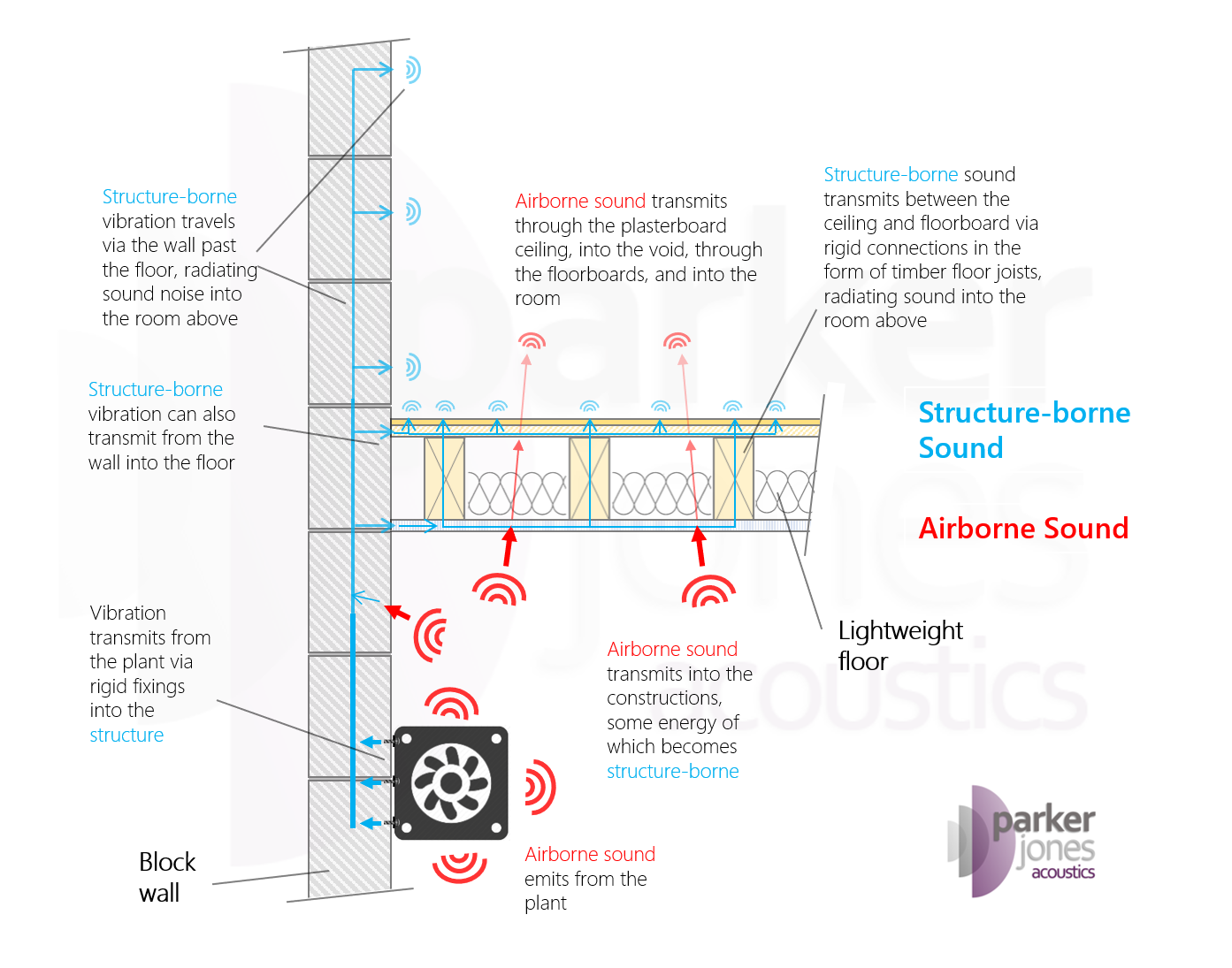Structure-borne sound
Sound is caused by vibrations which transmit through a medium and reach the ear or some other form of detecting device. Sound is measured in loudness (decibels (dB)) and frequency (Hertz (Hz)).
Sound in the built environment tends to be structure-borne or airborne.
Building Regulations Approved Document E - 'Resistance to the passage of sound' describes structure-borne sound as, ‘...sound that is carried via the structure of a building’. Structure-borne sound results from an impact on, or a vibration against, a part of a building fabric resulting in sound being radiated from an adjacent vibrating surface. A typical example of structure-borne sound is footsteps on a floor which can be heard in a room below.
Structure-borne sound comprises five processes:
- Generation – the source of an oscillation.
- Transmission – the transfer of oscillatory energy from the source to the structure.
- Propagation – the distribution of energy throughout the structural system.
- Attenuation - when waves moving through structures encounter structural or material changes they can be partially reflected which reduces the energy transmitted, and so attenuates the sound.
- Radiation – the emission of sound from an exposed surface.
Structure-borne sound and airborne sound are sometimes considered to be separate entities but they are closely related. Structural vibrations may radiate from surfaces, creating airborne sound, and airborne sound may cause an element of the building fabric to vibrate when it encounters a surface.
Structure-borne sound can be reduced by:
- Carpets and pads.
- Resilient underlay – which can have a similar effect to carpets and pads. Generally, they are made from recycled rubber, rigid fibreglass, foam or other such materials.
- Resilient mounts, sound clips or spring ceiling hangers.
- Soundproofing compounds. Typically the compound is applied between two rigid materials, such as subflooring. The compound dissipates the vibrations caused by sound waves as they move through the structure.
- A suspended ceiling system, raised floor or secondary wall structure.
- High mass constructions that include cavities or offset constructions to prevent transmission of vibrations.
Careful consideration must be given to structure-borne sound when designing buildings. However, the nature of structure-borne sound varies significantly depending on the source of the vibration, the composition of the structure through which it transmits, the radiating surface and the character of the receiving space. This is a complex subject and the design of sensitive spaces such as recording studios can benefit from the advice of an acoustic consultant.
Building Regulations Approved Document E - 'Resistance to the passage of sound' sets minimum standards for impact sound insulation. Impact sound transmission is typically measured in-situ with a tapping machine which uses steel-faced hammers to strike a test surface and generate sound in an adjacent space which can be recorded or monitored. This is useful only in giving an indication of the likely level of impact sound as it does not accurately represent the variety of impacts that might be experienced in practice.
The diagram below provides an example of structure-borne noise paths compared to airborne noise paths, for an item of mechanical plant, transmitting sound into a room above. (Credit: ParkerJones Acoustics)
[edit] Related articles on Designing Buildings Wiki
- Acoustic design for health and wellbeing.
- Acoustics.
- Acoustics in the workplace.
- Airborne sound.
- Approved Document E.
- Ash deafening.
- Building acoustics.
- Building Bulletin 93: acoustic design of schools.
- Building regulations.
- Decibel.
- Impact sound.
- Flanking sound.
- Noise nuisance.
- Pre-completion sound testing.
- Reverberation time.
- Robust details certification scheme.
- Sound absorption.
- Sound frequency.
- Sound insulation.
- Sound reduction index (SRI).
- Sound v noise.
- Underlay.
Featured articles and news
RTPI leader to become new CIOB Chief Executive Officer
Dr Victoria Hills MRTPI, FICE to take over after Caroline Gumble’s departure.
Social and affordable housing, a long term plan for delivery
The “Delivering a Decade of Renewal for Social and Affordable Housing” strategy sets out future path.
A change to adoptive architecture
Effects of global weather warming on architectural detailing, material choice and human interaction.
The proposed publicly owned and backed subsidiary of Homes England, to facilitate new homes.
How big is the problem and what can we do to mitigate the effects?
Overheating guidance and tools for building designers
A number of cool guides to help with the heat.
The UK's Modern Industrial Strategy: A 10 year plan
Previous consultation criticism, current key elements and general support with some persisting reservations.
Building Safety Regulator reforms
New roles, new staff and a new fast track service pave the way for a single construction regulator.
Architectural Technologist CPDs and Communications
CIAT CPD… and how you can do it!
Cooling centres and cool spaces
Managing extreme heat in cities by directing the public to places for heat stress relief and water sources.
Winter gardens: A brief history and warm variations
Extending the season with glass in different forms and terms.
Restoring Great Yarmouth's Winter Gardens
Transforming one of the least sustainable constructions imaginable.
Construction Skills Mission Board launch sector drive
Newly formed government and industry collaboration set strategy for recruiting an additional 100,000 construction workers a year.
New Architects Code comes into effect in September 2025
ARB Architects Code of Conduct and Practice available with ongoing consultation regarding guidance.
Welsh Skills Body (Medr) launches ambitious plan
The new skills body brings together funding and regulation of tertiary education and research for the devolved nation.
Paul Gandy FCIOB announced as next CIOB President
Former Tilbury Douglas CEO takes helm.
UK Infrastructure: A 10 Year Strategy. In brief with reactions
With the National Infrastructure and Service Transformation Authority (NISTA).























